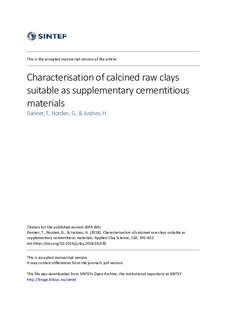| dc.contributor.author | Danner, Tobias | |
| dc.contributor.author | Norden, Geir | |
| dc.contributor.author | Justnes, Harald | |
| dc.date.accessioned | 2019-01-22T06:47:10Z | |
| dc.date.available | 2019-01-22T06:47:10Z | |
| dc.date.created | 2018-07-08T12:07:46Z | |
| dc.date.issued | 2018 | |
| dc.identifier.citation | Applied Clay Science. 2018, 162 391-402. | nb_NO |
| dc.identifier.issn | 0169-1317 | |
| dc.identifier.uri | http://hdl.handle.net/11250/2581665 | |
| dc.description.abstract | The potential use of two raw clays (Clay A: kaolin; Clay B: calcareous montmorillonite) as supplementary cementitious material (SCM) in blended cements was investigated. Cement replacement in mortars by 20% calcined Clay A and Clay B resulted in a considerable 28 day compressive strength improvement. The pozzolanic reactivity of Clay A and B is explained by characterisation of the structural changes upon calcination with XRD, ICP-MS, FT-IR, 27Al NMR, Mössbauer spectroscopy and SEM. At the temperature giving highest pozzolanic reactivity, kaolinite and montmorillonite were completely dehydroxylated, while calcite from Clay B was not completely decomposed. FT-IR, 27Al NMR and Mössbauer spectroscopy revealed considerable structural deformations of kaolinite in Clay A and montmorillonite in Clay B resulting in an amorphous, reactive state. Oxidation of iron in Clay B during calcination contributed to strong distortions of the octahedral sheet in the montmorillonite structure. Additionally, the formation of a glass phase due to reaction of coccoliths (CaCO3) and montmorillonite was observed. | nb_NO |
| dc.language.iso | eng | nb_NO |
| dc.publisher | Elsevier | nb_NO |
| dc.rights | Attribution-NonCommercial-NoDerivatives 4.0 Internasjonal | * |
| dc.rights.uri | http://creativecommons.org/licenses/by-nc-nd/4.0/deed.no | * |
| dc.subject | Pozzolan | nb_NO |
| dc.subject | Cement | nb_NO |
| dc.subject | Coccolith | nb_NO |
| dc.subject | Mössbauer spectroscopy | nb_NO |
| dc.title | Characterisation of calcined raw clays suitable as supplementary cementitious materials | nb_NO |
| dc.type | Journal article | nb_NO |
| dc.type | Peer reviewed | nb_NO |
| dc.description.version | acceptedVersion | nb_NO |
| dc.rights.holder | © 2018 Elsevier B.V. All rights reserved. This is the authors' accepted and refereed manuscript to the article. Released with a Creative Commons Attribution Non-Commercial No Derivatives License. The final publication is available at https://doi.org/10.1016/j.clay.2018.06.030 | nb_NO |
| dc.subject.nsi | VDP::Teknologi: 500 | nb_NO |
| dc.source.pagenumber | 391-402 | nb_NO |
| dc.source.volume | 162 | nb_NO |
| dc.source.journal | Applied Clay Science | nb_NO |
| dc.identifier.doi | 10.1016/j.clay.2018.06.030 | |
| dc.identifier.cristin | 1596234 | |
| cristin.unitcode | 7401,30,40,0 | |
| cristin.unitname | Arkitektur, byggematerialer og konstruksjoner | |
| cristin.ispublished | true | |
| cristin.fulltext | postprint | |
| cristin.qualitycode | 1 | |

